The best lawn tiller helps to get a perfect lawn. One of the most desired features in many gardens around the world. A well-maintained lawn not only complements the flower beds and borders but also provides space for your family.
Kids can play fun games, family pets can run about and in the summer when you desire to stay outdoors, you can enjoy the warmth by sun-bathing on the grass.

As an avid gardener, you may have complications with the growth of your lawn. Some of these complications stem from underlying issues deep within the soil structure. Getting a solution for such a problem may require an ideal tool like a lawn tiller.
Whether you’re buying your first lawn tiller or simply replacing your old one, this guide is here to help you pick the right model for your requirements.
What Are the Differences Between Lawn Tillers and Cultivators?
First, let’s distinguish between lawn tillers and cultivators. The mistake many people make is to think tillers and cultivators usually refer to the same thing. Even though they’re both used for the same purpose – to dig and stir the soil, you will often hear even landscaping experts use those terms interchangeably.
Regardless of the confusion, it is important to know that tillers and cultivators are two distinct pieces of equipment with variations when it comes to tasks they perform.
A lawn tiller serves to break up solid and compact soil. Breaking up hard pieces of the ground is important when you want to prepare the ground for planting. They have larger and stronger tines that can withstand the arduous task of breaking a new garden allotment. The added weight of tillers helps when you encounter rocky soil that needs to be loosened.
Meanwhile, cultivators have smaller engines and are not made for the tougher assignments done by tillers. A cultivator serves to mix the soil that is already broken into soft lumps and mix it with fertilizer, manure, or compost. It is also used to weed out unwanted plants and grasses to prevent them from spreading over your lawn.
Why Do You Need a Lawn Tiller?
A healthy, lush, and green lawn brings life to your outdoor space. Achieving a great looking lawn requires you to do the regular maintenance of the soil structure in which the grass will grow.
Tilling is important when you want to install a new lawn or to improve an old one. What tilling does is it helps prepare the soil so that you can plant new seeds. A lawn tiller comes in handy for such purposes. Here is why you need a lawn tiller.
-
Aerate the Soil
A lawn tiller helps to loosen the soil. When the soil structure is softened, it provides a good footing for newly germinated grassroots. Other than that, the loose soil will facilitate the roots to access much-needed oxygen, water, and nutrients. Aeration is needed by many of the microorganisms that release plant nutrients to the soil.
The air that is found above ground is very different from the one found in soils. The reason for this is due to the different levels of carbon dioxide found in both conditions. Since the soil has higher levels of carbon dioxide, oxygen levels may be impacted. Since grass must access enough oxygen to flourish, having a lawn tiller will help to allow proper aeration of the soil.
-
Weed Control
If your beautiful lawn is infested by weeds, then you will appreciate the advantages of having a lawn tiller. Weeding is an important control method practiced by many healthy gardens. What weeds do to the grass is they deny the grass access to essential nutrients, moisture, and light.
Weeds can also block the sprinkler and restrict grass growth. There is also a potential risk from frost because weeds form a layer that insulates the soil surface. If that’s not all, weeds increase the risk of harm to the grass by hosting destructive pathogens.
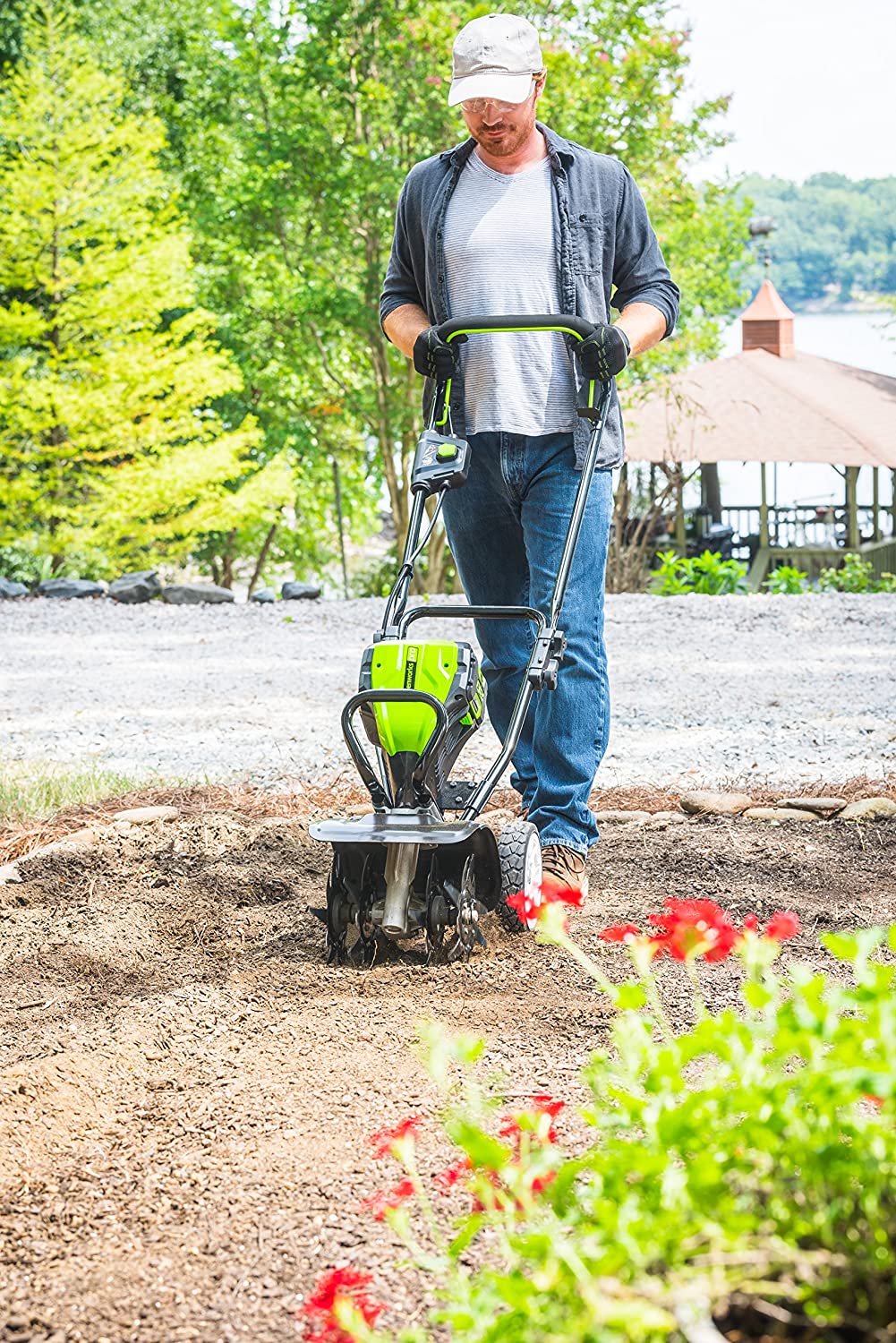
-
Eliminates Pests
Among the many advantages of tilling is that it can derange soil-borne larvae. Some microscopic insects perform very important functions in the soil. These insects play a vital role in the supply of nitrogen that is needed for the health and the growth of the grass. However, other soil insects are the exception and are considered harmful.
Among the most destructive of all lawns, pests are white grubs. During spring, summer, and early fall, these soft, plump, and gray-white larvae feast on lawn grass just below the soil surface. White grubs cause widespread damage and the most destructive pests in turfgrass. Many pests nest under the soil during winter and tilling will kill many of these.
-
Warming the Soil
As the winter progresses, you should get an early start and plan for the spring. And the earlier you can start growing the grass, the better. Planting early in the spring means that you can get the lawn prepared and get a lush, green surface much sooner.
Breaking the soil by tilling will allow better absorption of water by the soil and enable it to hold on to daytime heat better. Whether you’re tilling for an early spring or preparing the lawn over a mild winter, getting a lawn tiller is a move that will reap great rewards.
-
Soil Amendment
In poorly prepared lawns, the topsoil is often carelessly mixed with varying proportions of the components that make a quality soil. In other situations, the soil available is not of the right type to support the growth of top-grade turfgrass. Clay, silt, and sand the basic components that make up the different types of soil. The ideal combination is 20 percent clay, 40 percent silt, and 40 percent sand to make loam soil.
Loam soil is highly regarded for its qualities of nutrients retention and proper damage. You can use a lawn tiller to amend the soil together with organic matter to achieve the desired mixture before seeding the lawn.
Which Type of Lawn Tiller is Available?
Lawn tillers are a tremendous convenience when it comes to preparing and tending the lawn. Not only do they save time but also relieve you from back-breaking work. It is important to have one that can handle all the heavy tilling work and won’t break down.
There are lawn tillers on the market to suit every demand. They are available with varying degrees of portability and the type of work it can best be applied to do. If you’re shopping for a new lawn tiller, you’ll run into four main types: front tine tiller, mid tine tiller, rear tine tiller, and vertical tine tiller. If you are eager to purchase a tiller for your garden, It is easy to get overwhelmed when you’re confronted by the different types of tillers.
We will share the details to help you decide which one is right for your lawn project.
Front Tine Tiller
A front tine tiller is the smallest of the quartet and cheaper too. As a result, it is one of the most common tillers that home gardeners use. With this type of lawn tiller, the tines are located in front of the engine. The tines are standard rotating which means that they rotate forward in the same direction as the wheels.
Because of their small size, front tine tillers are perfect for tilling narrow gaps. Another advantage is it’s possible to adjust the tine width. Most of the manufacturers make the equipment available with three width settings to make it as flexible as possible.
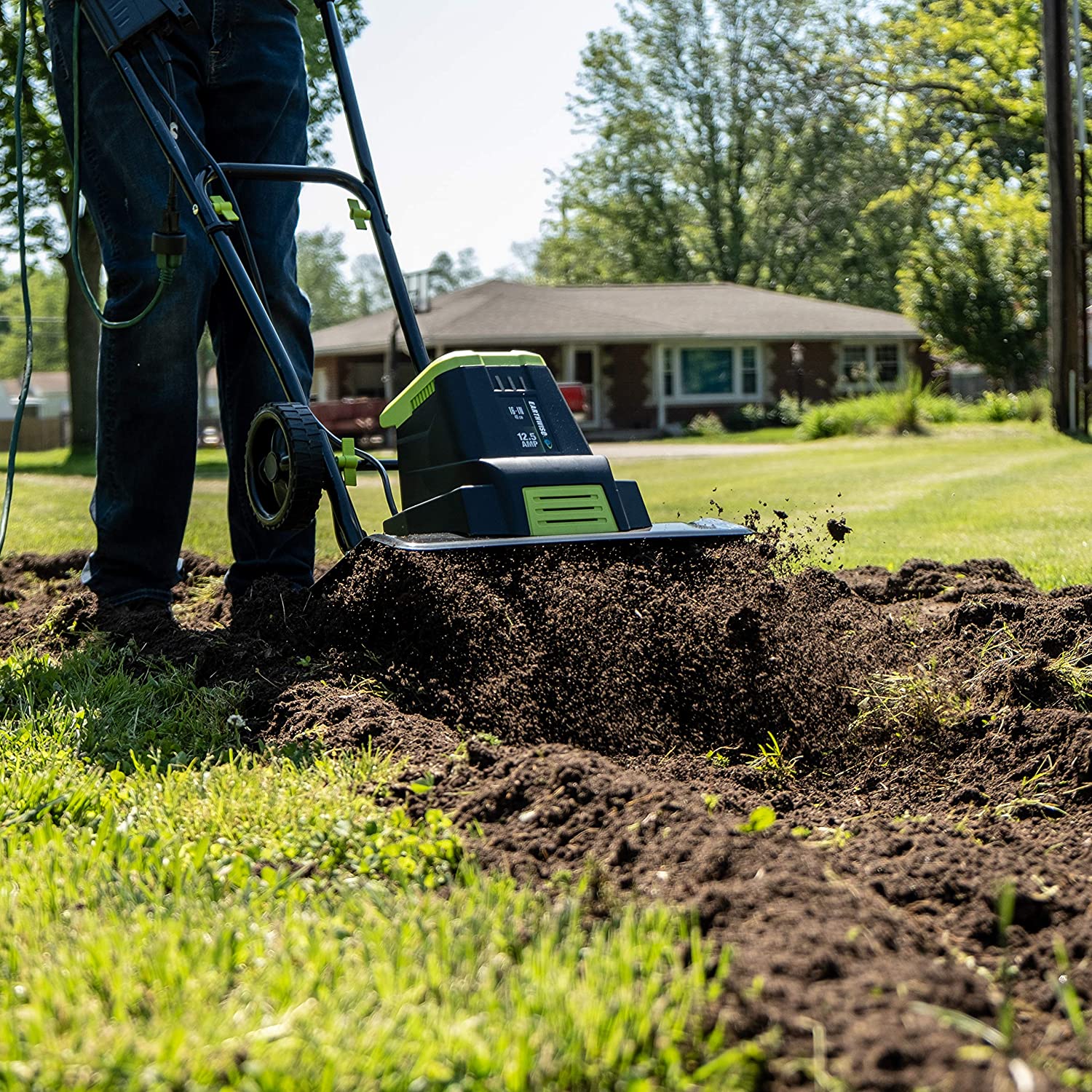
Mid Tine Tiller
Mid tine tillers are closely related to front tine tillers save for a slight difference in both their designs. With this type of tiller, the tines are located directly beneath the engine. Once again, this model type is still propelled by the tines.
The location of the tines allows for better balance and control and it also makes it easy to maneuver. The wheels on this tiller are only used to transport it to the worksite. Once you are ready to commence tilling, you pivot the wheels and then lower the drag. The drag allows the operator to control the forward movement of the tiller by regulating the downward pressure on the drag bar.
Rear Tine Tiller
Rear tine tillers are larger than the other two tillers mentioned above. The size makes them useful for large-scale jobs or for tilling hard ground that has not been worked on before. They are typically easier to use because the tines are not used to propel the motion of the machine.
Utilizing a pair of powered wheels to move the tiller, it remains stable which allows it to dig to the desired depth and length. Rear tine tillers have different types of driving mechanisms. They can be either belt-driven, hydraulic, or all-gear-driven.
Vertical Tine Tiller
Vertical tine tillers are the newest entrants to the category of lawn tillers. These machines have tines that cut forward through the soil rather than downwards like the other tillers mentioned. This makes them one of the fastest tillers while offering the smoothest experience.
The tines work like an eggbeater while tilling forward. It makes easy work in areas where clay-filled earth and hard-packed soil are more prominent. Vertical tine tillers can create lawns that are finely tilled in just one pass.
What Factors Should You Consider When Buying A Lawn Tiller?
Now that you know the different types of lawn tillers you can find in the market. It’s time to look at the important factors you need to consider before splurging your money on a new tiller. You want to ensure that it will be a good fit for your needs.
Knowing what to look for when purchasing a lawn tiller will not only save you money but also frustration down the road.
Type of Soil
The type of soil in your lawn will dictate a lot with how challenging the tilling will be. Clay soils are typically harder to break and will require extra power to manage effectively. Rocky soils require not only tillers that are armored for protection against flying rock, but also a special type of tines that can handle the difficulty.
If you are lucky to have soft soil, you will have an easy time as most tillers can cope up with the digging. Doing a little research is a worthy undertaking to be sure that a tiller is the best fit for the kind of soil you have.
Lawn Size
Many suburban homes are on much smaller lots that don’t necessitate the need for large rear tine tillers. But in rural homes where the trend is to have large lawn spaces, it greatly reduces the workload. The size of your lawn has a direct correlation with how big of a job you will have tilling each season.
While almost all tillers will do the job irrespective of the lawn size, bigger and more powerful tillers adequate for large lawns. Front tine tillers are best suited for smaller gardens.
Buy or Rent
As the title suggests, you might find yourself having to rent a tiller at first before committing to getting your own. This is because you will need a different type of tiller if you are breaking new ground from scratch. If you purchase a lawn tiller for that specific purpose, you may not have much use for it in the future.
You can probably do with renting a powerful tiller for the initial groundbreaking before buying a more suitable model for ongoing lawn maintenance. However, if you are a professional landscaper with a lot of commercial call-outs, picking a powerful tiller will make your work faster and easier.
Energy Source
Electric tillers have become more popular due to their desirable characteristics of lightweight and ease of use. Such models can either be cordless or ones that have to be plugged into a power source. This limits the amount of time you can operate battery-powered models or the range of use.
While electric lawn tillers are easy to use and affordable, they are much less powerful than gasoline tillers. If you need to do a big job fast and efficiently, your best bet is to spend a little more money on a conventional tiller and save yourself time and energy as a result.
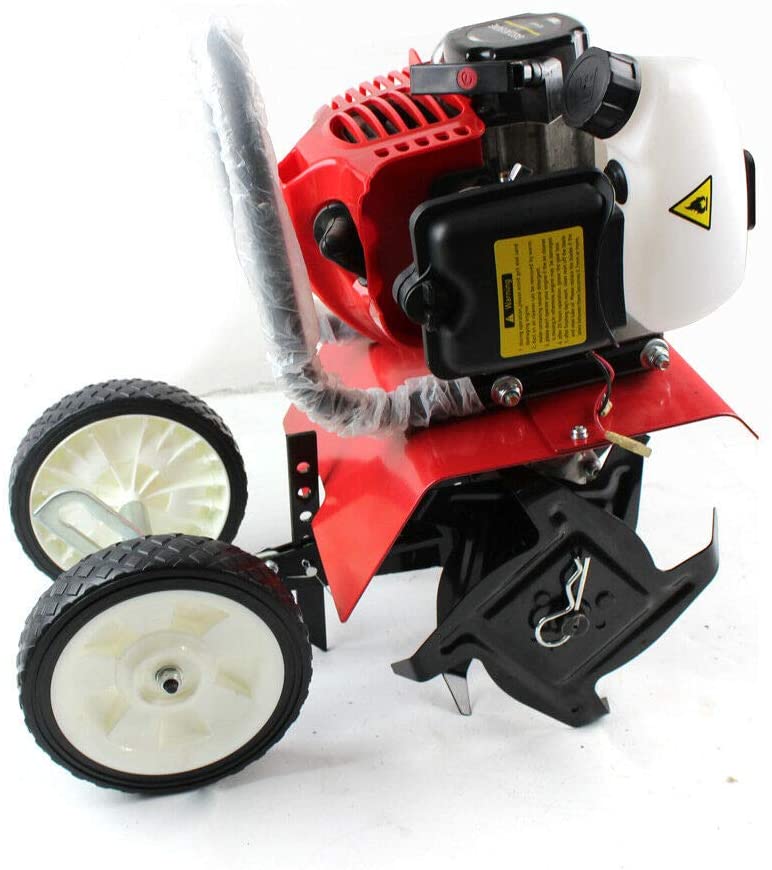
Tine Rotation
In the case of rear tine tillers, you have a few options to consider concerning the rotation of the tines. Standard rotating tines are good for shallow depths of up to five inches. Harder soil types like clay, require more power to break up the hard ground. Counter-rotating tines are more effective for such jobs.
Dual rotating tines offer both options in the build of your tilling machine. This gives you the flexibility of adapting to the situations you might find while preparing your lawn. Understanding your soil type will ensure you tackle the job at hand with the right tine.
Cost and Size
The price of a lawn tiller is a deciding factor when it comes to finding the right one for you. Depending on your budget, how much you can spend may skew you towards a certain type of tiller. Front tine tillers are usually on the lower end of the price range. Rear tine tillers and vertical tine tillers are a step above in cost.
How much space do you have? Tillers need to be stored somewhere when not in use. Identify space in your garage or storage shed where you can secure your tiller. Small tillers have the advantage of being easy to store while bigger models like the rear tine tiller can be tricky to find a good spot to keep them.
6 Best Lawn Garden Tillers
Choosing the best lawn tiller can be a confusing task with so many models on the market. There are four main types of tillers at hugely differing prices and all with different features that need to be regarded. To make the decision easier for you, we will highlight a few of the benefits and drawbacks of each of the models we will list.
Our list of six of the best lawn tillers come from reputable manufacturers of made to last equipment. You will appreciate the range of products on the list. To make the process simple for you, we will explain the various functions and additional features so that you can make an informed choice on the best lawn tiller for you.
#6. Mantis 7940 4-Cycle Tiller
The Mantis 7940 is easily the best gas-powered lawn tiller available for the discerning homeowner. If you like the lawn beautiful and perfectly laid out, some of the features of this lawn tiller are very desirable.
For starters, It weighs in at just 24 pounds which means you won’t have a difficult time moving it around.
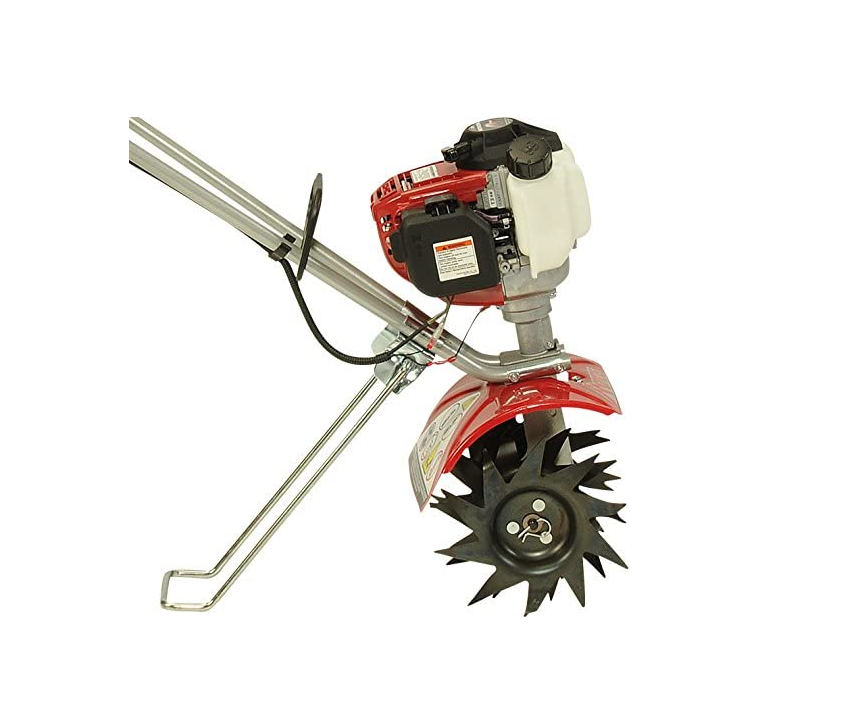
In the core of this compact size tiller is a premium 4-cycle 25cc engine supplied by Honda. The engine is strong enough to till and tear through the turf and compacted soil.
The Mantis 7940 has an attractive design with comfortable handles that provide an assured grip. The ergonomically flared handlebars minimize fatigue for your ease and comfort.
Pros
- Very easy to carry and maneuver in even in confined and limited spaces
- Handles fold down easily for convenient storage and transport to the lawn
- Specially designed tines help in digging deep into hard soil layers
- Requires no mixing of oil and gas and is very silent during operation
Cons
- When the tines are reversed, It can only till the top 2-3”
- It can only till up to 10” deep which may be insufficient for some tasks
- You may need more passes to complete certain jobs because it’s very narrow
#5. Sun Joe TJ600E Electric Garden Tiller
This lawn tiller is ideal for mid-sized lawns. It is especially very handy at starting a new lawn or recovering an old one. The Sun Joe TJ600E utilizes a powerful 6.5-amp motor that mirrors the performance of a gas-powered tiller.
You won’t break a sweat moving all that power around as this tiller tips the scale at just under 19 pounds.
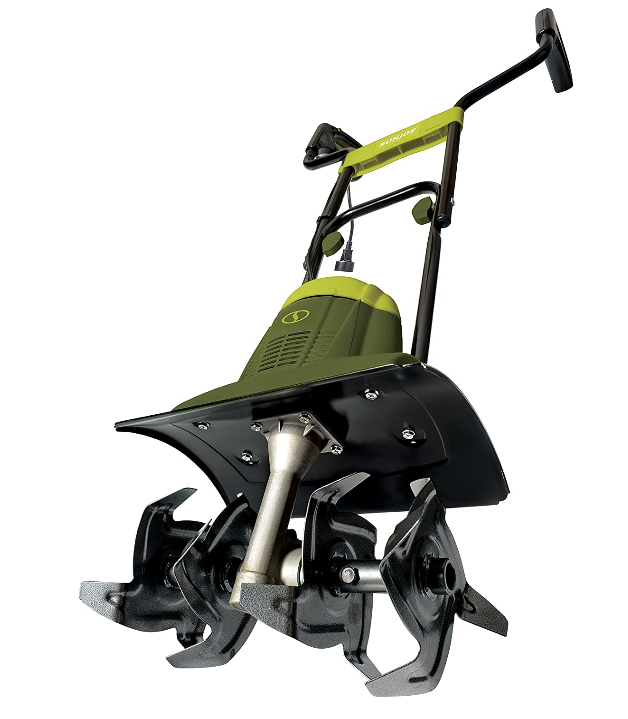
It can till an area 14-inches wide while digging 7-inches deep into the soil. The tines are angled to allow for efficient and undemanding operation when tilling the lawn, making planting of new grass and weed removal quick and easy.
Furthermore, the four tines provide maximum durability to enable continuous performance.
Pros
- It is very quick to start with a safety button to prevent unauthorized use
- Because it doesn’t use gas or oil, maintaining it is easy
- The handles can collapse for easy storage
- The tines are made of steel making them very durable
Cons
- It requires an electric extension cable that limits its range
- Some users have reported that it is a little noisy during operation
- It may suffer damage from rocks because the frame isn’t made of metal
#4. Yardmax YT5328 Compact Front Line Tiller
You won’t find many tillers nearly as versatile as this tiller. This impressive versatility comes from the ability to remove the tines and adjust the tilling widths from 11” to 21”.
Not only that because the Yardmax YT5328 can as well be adjusted to dig depths between 7” and 11”. The drag strip makes it easier to regulate the depth control to ensure you get a smoother till.
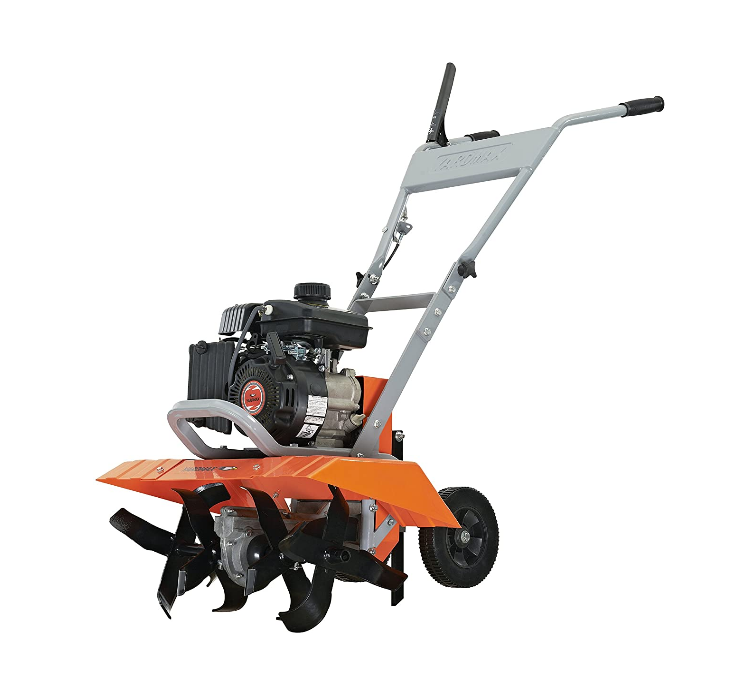
The powerful 98cc engine delivers 180 RPM to the tines, enough to chew through the hardest soil surface into a soft bed that’s perfect for your turfgrass.
This tiller weighs in at 95 pounds which may seem a lot but it’s surprisingly easy to maneuver it around as you make turns while tilling.
Pros
- It can dig deeper and wider than most of the other front tine tillers.
- The tines can be removed to improve maneuverability
- It burns the fuel cleaner to meet even the most stringent emissions guidelines
- The handlebars can be adjusted to three different positions for your ultimate comfort
- It includes a rust-resistant shield to shelter the tines
Cons
- The oil filler cap together with the attached dipstick is improperly placed
- You can vary the rotation speed as it is always on forward rotation
- It requires regular maintenance to keep it in working condition
#3. Earthquake Victory 29702 Rear Tine Tiller
If you have a particularly large lawn, then you will find this budget tiller very useful. Unlike other rear tine tillers, it wasn’t made for extensive commercial use.
As a result, you get the ultimate combination of power and durability for an affordable price. It comes with a 196cc engine to power the 11” rear-mounted tines, providing up to 16” of tilling.
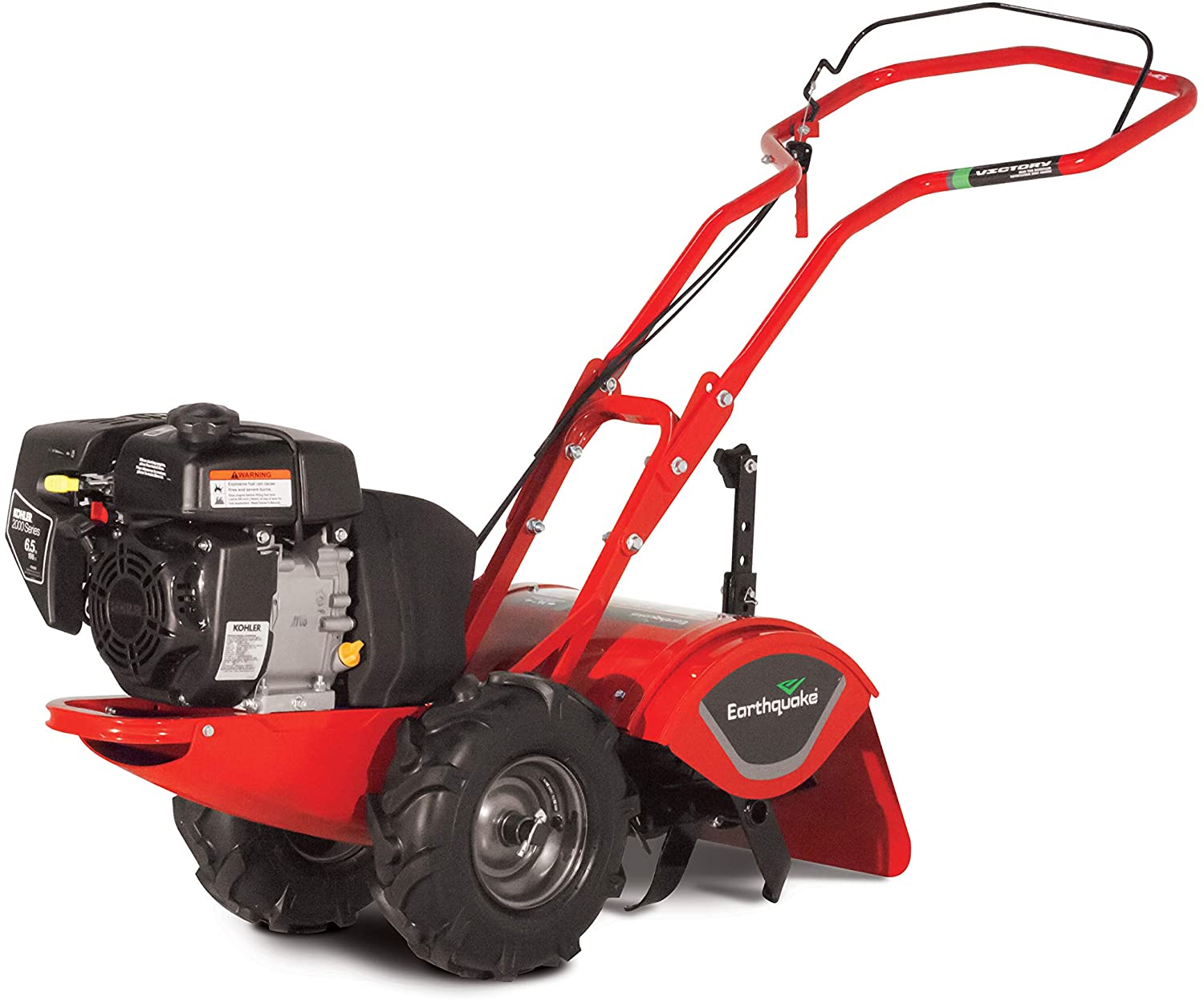
The tines are counter-rotating to enable deeper digging through when breaking new ground or soil that has compacted due to lack of maintenance. Single-hand control through sod is a feature many will find satisfying.
Couple it with airless wheels and the added reverse functionality, it gets good traction while maneuvering around the lawn.
Pros
- It is easy to assemble right out of the box
- The air-less design of the wheels means it is always ready for work
- It offers three height positions making it comfortable to work with
- Cast iron build protects the machine from damage
Cons
- Requires frequent tine cleaning
- Suffers from occasional choke issues
#2. Craftsman C210 9” 2-Cycle Tiller
If a small lawn rototiller is all that you need, you can’t go wrong with this option. The Craftsman C210 covers all the basic requirements for a lawn tiller with prominent features that make it very popular among gardeners. It was designed with a variable speed throttle to enable the user to work at their desired pace.
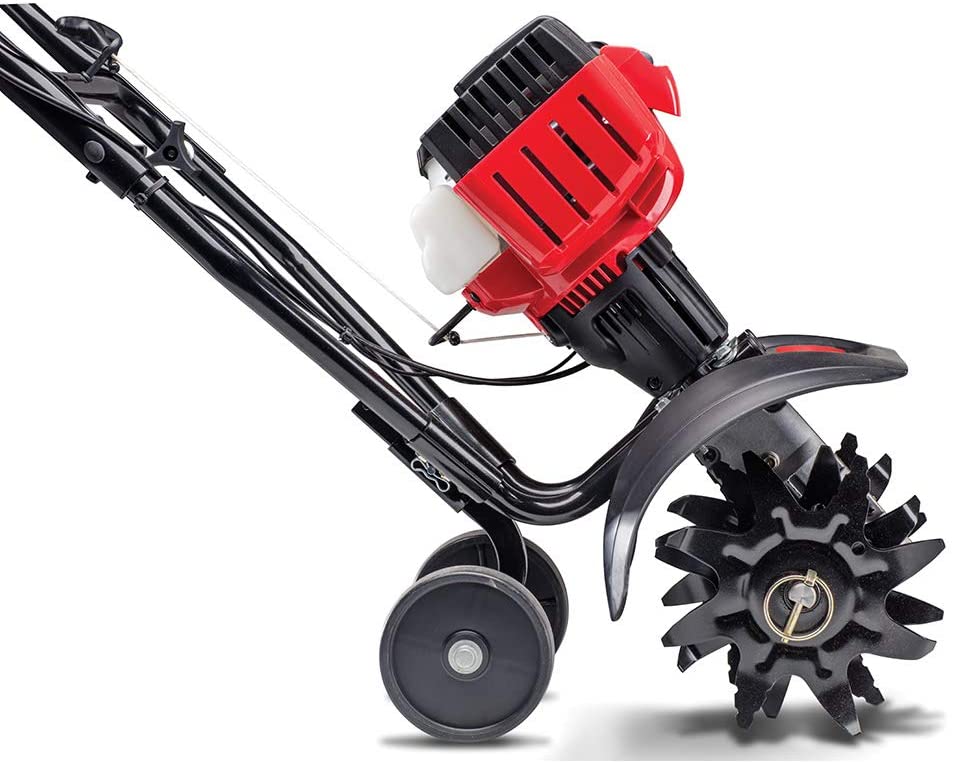
No one wants a tiller that is unable to break up tough and dense soil. The 25cc engine ensures none of that by powering the steel tines through the ground up to a depth of 5”.
The V-grip of the handles is comfortable to hold with no reports of blisters after sustained use. Starting gas-powered tillers can be cumbersome, however, this particular model is easy to start and operate.
Pros
- Users will not have much difficulty to operate and carry it around
- It is compact enough to reach into confined areas
- The engine is powerful enough considering its size
- The width is adjustable from 6 to 9 inches
Cons
- It is not available with adjustable handles
- There are reports of sudden failures in the first hour of operation
#1. Earthwise TC70001 11-Inch 8.5-Amp Electric Tiller
The Earthwise TC70001 is a great option for smaller lawns and limited budgets. Despite its affordable price, the tiller features a powerful 8.6-amp motor that delivers enough power to work through tougher ground such as compact clay soil or a virgin lawn that has never been tilled. An added benefit is it keeps your carbon footprint low because it runs on electricity.
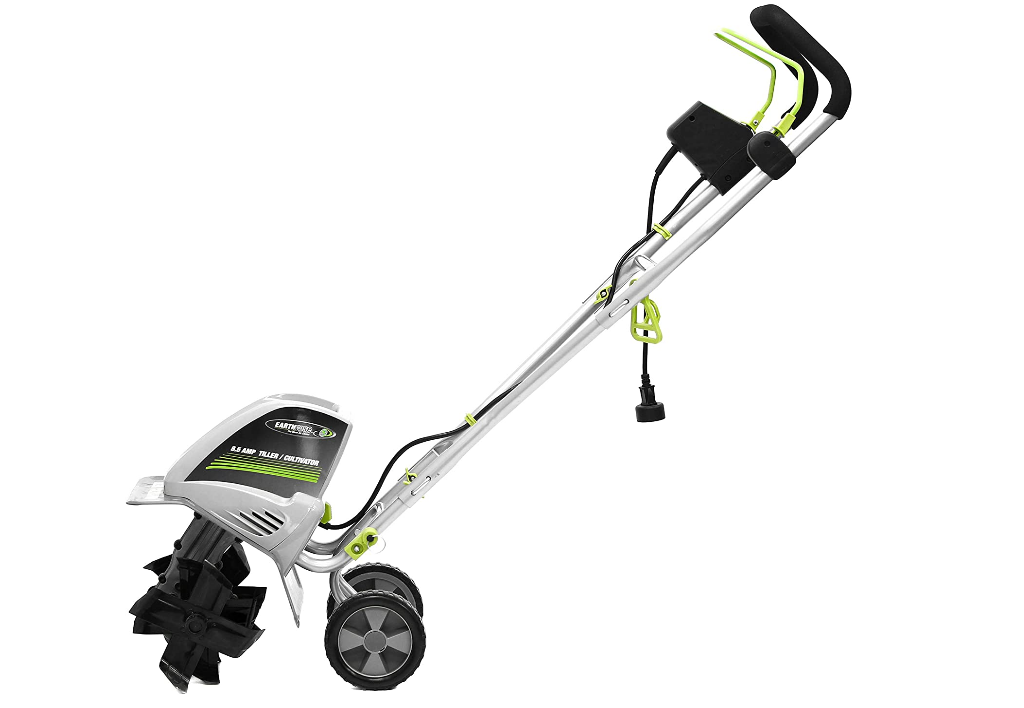
In terms of performance, it can cut width of 11 inches and up to a depth of 8.5 inches. At first glance, this may seem insufficient but this makes it perfect for small to mid-sized lawns.
The included wheels can be raised or lowered depending on whether you’re tilling or simply want to push it back to storage.
Pros
- It offers more bang for your buck with performance to boot
- Very easy to tote it around as it weighs only 25 pounds
- Equipped with both cultivating and tilling functionality
- With this equipment, tilling and cultivating is quick and easy
Cons
- You cannot adjust the cutting depth affecting versatility
- Like other electric tillers, it suffers from range limitations
Frequently Asked Questions
If you are still unsure about your purchase decisions, it’s probably because you still have questions that need to be addressed. We will go through some of the frequently asked questions to answer some of your queries.
Answer: The choice to buy an electric or gas tiller depends on the size of your lawn and whether you are breaking new ground or tilling an already bed. Electric models are best suited for small lawns while gas tillers are preferred for larger lawns.
Answer: It is recommended that you replace the fuel filter for your tiller after 100 hours of operation or every 3 months.
Answer: Maintaining the tines on your tiller is an important procedure that needs to be performed often. Remove the tines after every use and rid them of dirt and debris. Finally, spray them with a lubricant like WD-40 to insulate the tines from rust.
Answer: 2-cycle engines require the operator to premix a gas and oil mixture in the fuel tank to the recommended proportions. On the other hand, 4-cycle engines have separate inlets for oil and gas. For this type of engine, gas goes into the fuel tank while oil goes to the engine.
Conclusion
Everyone desires to have a beautiful lawn. It makes those sunny summer days a great experience. However, achieving a beautiful lawn requires you to make some effort in preparing the lawn to get the conditions necessary for healthy turfgrass. This is where a lawn tiller comes in handy by ensuring that your lawn gets the aeration and drainage it needs to continue thriving.
While it is important to select your lawn tiller based on your needs, any of the models we have listed can keep your lawn looking great through the seasons. If you find yourself in the market for a lawn tiller, you can be sure to rely on our best selections for guidance in your purchase decision.
Read More:

